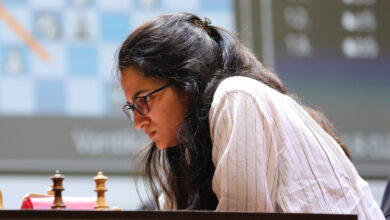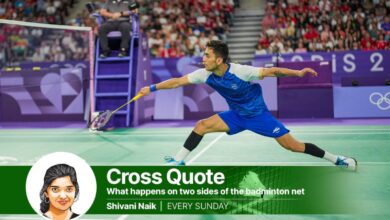Novak Djokovic vs Carlos Alcaraz: Hory repeating itself or a changing of the guard?

Shortly after Carlos Alcaraz’s two-hour-long 6-1, 6-2, 7-6 (5) demolition job on Stefanos Tsitsipas in the quarterfinal of the French Open on Tuesday, the Spaniard said: “I always say that if you want to be the best, you have to beat the best.”Alcaraz was not talking about the player he just spent the night pummelling into submission, but about the match he had just set up. On Friday, for the third successive year, the highlight event of the men’s draw at Roland Garros will take place before the final as Alcaraz, the 20-year-old World No. 1, takes on Novak Djokovic in the semifinal at Court Philippe Chatrier.Not enough buzz has been generated around the tournament about the hory that is on the line for Djokovic. The Roland Garros title will give the Serb a 23rd Major singles championship, allowing him to take the lead in the all-time Grand Slam race at the home of his rival, Rafael Nadal, perhaps for good, given Nadal’s latest injury trouble.
Full of respect 🤝@DjokerNole & @carlosalcaraz in each other’s words…#rolandgarros pic.twitter.com/EFANBZilpL
— Tennis TV (@TennV) June 8, 2023
It will also allow him to put to an end any talk of a changing of the guard moment taking out Alcaraz, who is not only multiple generations his junior (Alcaraz is closer in age to Djokovic’s children than he is to Djokovic), but also the sport’s rising superstar.
Clutch play
Tsitsipas may be the World No. 5 and a former French Open runner-up, but across the first two sets on Tuesday, Alcaraz made him look like a glorified amateur. In making his superiority brutally transparent, Alcaraz gave an exhibition of what has made his captivating game appointment viewing over the past year.
Not an inch of the court was out of his reach, winners were flowing from both wings, his drop shots were stopping time, and his opponent had no answers. But in the third set, Alcaraz let his level dip and failed to capitalise on three match point opportunities, letting the set get dragged out to a nervous tiebreak. Those kinds of lapses will lead him straight into Djokovic’s lair.
The match-up we’ve ALL been waiting for 🤩
Re-live @carlosalcaraz & @DjokerNole‘s ONLY meeting so far! ⚡️@MutuaMadridOpen pic.twitter.com/s9WErGYplc
— Tennis TV (@TennV) June 7, 2023
The Serb did not have the same kind of one-sided wins in his run to the semifinal, but rather tetchy affairs against Alejandro Davidovich Fokina in the third round and Karen Khachanov in the quarterfinal. But despite his evident and legendary tennis weapons, his single greatest strength remains his ability to wear his opponents down until they begin leaking errors. Even on his worst days, Djokovic can take matches and sets deep just staying alive in long rallies and keeping his serve firing well enough until an opportunity presents itself, either in the set, or the resultant tiebreaker – potential make-or-break shootouts in best-of-five tennis.
Djokovic has won each of the five tiebreakers he has played at Roland Garros this year, but here’s the kicker – in the 43 tiebreak points he has played, he has not made a single unforced error. There are clutch players, and then there is Djokovic. Totally seamless in battles of attrition.
Alcaraz won their only previous match, the semifinal of the Madrid Masters last year. Of the two tiebreakers played that day – also contested on red clay but a quicker surface than the one in Paris – Djokovic won the first, and Alcaraz prevailed in the decider. The Serb left knowing he had ceded ground, something he is unlikely to do at a Major.
INTO THE SEMIS 👀🇪🇸#RolandGarros | @carlosalcaraz pic.twitter.com/pQ7RHa9BiY
— Roland-Garros (@rolandgarros) June 6, 2023
Awkward matchup
One of the startling things about Alcaraz’s meteoric rise this year has been how complete his game already is. Despite the creative and dynamic edge, he is adept at going toe-to-toe with anyone from the baseline, can indulge in more conventional patterns of play, and does not have any direct weaknesses that Djokovic can penetrate.
But his ability to end points early are a big mark of how he blows past his opponents. He does so using the easy power and spin he enjoys from the baseline – particularly his fiercer forehand – to push his opponents further and further behind the baseline and opening the court to finish points at the net (even serve and volley), and throw in his signature drop shots.
Explained Why Alcaraz’s second serve will be crucial The second serve never fails to be an underrated tennis weapon – get it wrong and lose the only element of the game in your control. And Alcaraz often gets it right. Alcaraz has won a tournament-leading 62% of points on his second serve in his five matches in Paris so far, as opposed to Djokovic’s 54%. Alcaraz usually uses the kick serve out wide – particularly on the ad court to send a right-hander trailing on the backhand side – on his second serve to open up the court for his next shot. But Djokovic’s mastery of the return, return positioning, and backhand, make him the perfect player to counter that strategy. In last year’s quarterfinal, Nadal kept Djokovic at bay keeping the speeds of his second serve consently high and placing them near the body, trying not to play into the Serb’s wheelhouse. It remains to be seen if Alcaraz opts for a similar option or sticks to his original strategy, but if he is able to keep up his second serve numbers, he will almost certainly hold the edge.
However, unlike most others on tour that choose to respond to power and spin retreating to the back of the court, Djokovic is comfortable staying tight to the baseline, taking the ball high and early and redirecting pace, even on the sluggish and slow surface in Paris. This could dinctly reduce the breathing space Alcaraz enjoys to add variety to his game, forcing him to indulge in more and longer baseline exchanges, which, thanks to Djokovic’s backhand, could play into the Serb’s hands.
Despite his forehand being his stronger wing, Alcaraz has enjoyed easy wins against each of his last three opponents exposing their weaker one-hander in the backhand exchanges. Not only does Djokovic have a two-hander, it is one of the best in the sport’s hory, which he can use to paint the lines for winners, but is majorly effective in wearing opponents down in long rallies.
🔜 SEMIS IDEMOOO 💪🏼🙌🏼🙏🏼🎾🔥☄️🇫🇷 #RolandGarros pic.twitter.com/2sT5KIE2Qh
— Novak Djokovic (@DjokerNole) June 6, 2023
Djokovic’s baseline strategy might also hinge on how to make Alcaraz impatient. His western grip allows him to find acute angles on the forehand crosscourt, which could send Alcaraz wider into his own forehand wing, opening up the court for him to play the risky, low-percentage shot down the line. Alcaraz has shown a tendency to be trigger-happy on his forehand in the past.
Much of this match will depend on Alcaraz’s strategy. He will have to make a choice between sticking to his natural dynamic game or to make minor tactical adjustments to deal with a legendary opponent. Alcaraz has got the game to outplay anyone, but Djokovic has got the experience and added motivation to curb it. Despite the minute analysis – tennis at this level often comes down to the finer margins – this is undoubtedly a generational matchup. Djokovic’s bid for the crown will meet Alcaraz’s drive to prove he is its true heir. Fireworks, one way or another, are to be expected.







